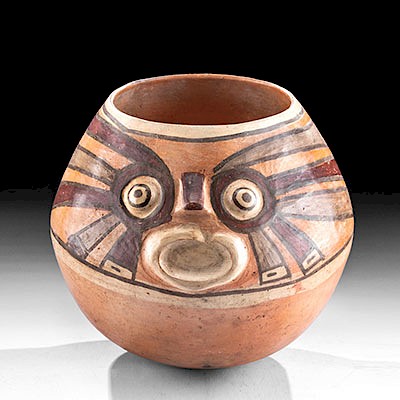2 Framed & Signed R. C. Woodville Paintings, WWI Scenes
Lot 169
About Seller
Artemis Fine Arts
686 S Taylor Ave, Ste 106
Louisville, CO 80027
United States
Selling antiquities, ancient and ethnographic art online since 1993, Artemis Gallery specializes in Classical Antiquities (Egyptian, Greek, Roman, Near Eastern), Asian, Pre-Columbian, African / Tribal / Oceanographic art. Our extensive inventory includes pottery, stone, metal, wood, glass and textil...Read more
Categories
Estimate:
$2,000 - $4,000
Absentee vs Live bid
Two ways to bid:
- Leave a max absentee bid and the platform will bid on your behalf up to your maximum bid during the live auction.
- Bid live during the auction and your bids will be submitted real-time to the auctioneer.
Bid Increments
| Price | Bid Increment |
|---|---|
| $0 | $25 |
| $300 | $50 |
| $1,000 | $100 |
| $2,000 | $250 |
| $5,000 | $500 |
| $10,000 | $1,000 |
| $20,000 | $2,500 |
| $50,000 | $5,000 |
| $100,000 | $10,000 |
| $200,000 | $20,000 |
About Auction
By Artemis Fine Arts
Dec 5, 2019
Set Reminder
2019-12-05 10:00:00
2019-12-05 10:00:00
America/New_York
Bidsquare
Bidsquare : Ancient / Ethnographic - Holiday Edition
https://www.bidsquare.com/auctions/artemis-gallery/ancient-ethnographic---holiday-edition-4710
What to give this holiday season? Ancient & Ethnographic Art of course! Our special Holiday auction features hundreds of unique finds from all over the world. Artemis Fine Arts info@artemisfinearts.com
What to give this holiday season? Ancient & Ethnographic Art of course! Our special Holiday auction features hundreds of unique finds from all over the world. Artemis Fine Arts info@artemisfinearts.com
- Lot Description
Richard Caton Woodville (British, 1856-1927). "A Modern Catapult" & "A Gallant Irishman's Splendid Stand", both watercolor & gouache. December 19, 1914 & November 9, 1914 respectively, signed at lower left. Two paintings of WWI dramatic charges and heroic stands by Richard Caton Woodville, an artist who not only helped define the genre of military art but also shaped the public's visual understanding of warfare. "A Gallant Irishman's Splendid Stand" uses a pyramidal formula to capture a courageous moment in which the "Irishman" grips his weapon and stands upon a pile of corpses in trenches as soldiers approach above. "A Modern Catapult" depicts soldiers operating the catapult from the trenches - one holding the trigger, one lighting the gunpowder, one looking out, and a fourth, surrounded by shovels and weapons, resting until it is his turn to help. In the upper right corner, Woodville has provided an illustration of the "Modern Catapult" with a key to identify its parts. Size: 11.5" L x 9" W (29.2 cm x 22.9 cm); 17.625" L x 14.3" W (44.8 cm x 36.3 cm) framed
Richard Caton Woodville was born in London to two artists, an American father and a Russo-German mother. He studied art in Germany at the respected Dusseldorf Academy. As an artist, Woodville focused on dramatic military scenes that oftentimes highlighted the power of the British Empire. His work was very popular during the Victorian era, and Queen Victoria actually commissioned several works from Woodville. Illustrated London News sent Woodville to cover the Russian-Turkish War of 1877-78 as well as to Egypt in December 1882 for the war with Britain. Interestingly, most of his work was done in the studio which was filled with all matter of military props and uniforms to use as references.
Frederic Villiers claimed that Richard Caton Woodville was the best British battle painter, and wrote that "next to de Neuville and Verestchagin, the greatest painter of war pictures is undoubtedly Mr. Caton Woodville … in his pictures is all the real dash and movement of war". Van Gogh also admired Woodville's work, especially his depiction of the Irish poor in the Illustrated London News.
Sadly, by the end of his life, Woodville's work fell out of fashion, and impoverished and depressed, he eventually committed suicide. Despite this tragic demise, his artwork truly defined the military genre through World War I.
Provenance: estate of William Stockton, Colorado, USA; acquired in mid 20th century from The Veerhoff Galleries in Washington D.C.
All items legal to buy/sell under U.S. Statute covering cultural patrimony Code 2600, CHAPTER 14, and are guaranteed to be as described or your money back.
A Certificate of Authenticity will accompany all winning bids.
We ship worldwide and handle all shipping in-house for your convenience.
#150816Both paintings are set behind a grey mat under glass in a silver-toned wooden frame. Neither has been examined outside the frame, however both appear to be in very good condition. Both are signed at the lower left. Gallery paper on versos shows stains, but damage does not appear to have affected the artwork - there is a board between the paper and the paintings. There is a bit of staining to the lower right corner of the mat on "A Gallant Irishman's Splendid Stand". On the verso at the upper center are gold labels from The Veerhoff Galleries in Washington D.C. (established 1871). At the bottom are exhibition labels that include the dates, titles, etc. Both are wired for suspension.Condition
- Shipping Info
-
All shipping is handled in-house for your convenience. Your invoice from Artemis Gallery will include shipping calculation instructions. If in doubt, please inquire BEFORE bidding for estimated shipping costs for individual items.
-
- Buyer's Premium



 EUR
EUR CAD
CAD AUD
AUD GBP
GBP MXN
MXN HKD
HKD CNY
CNY MYR
MYR SEK
SEK SGD
SGD CHF
CHF THB
THB


















